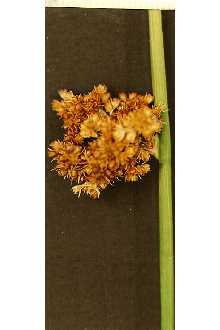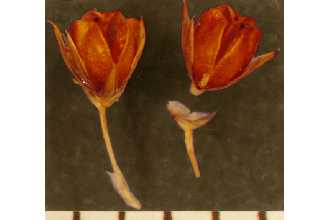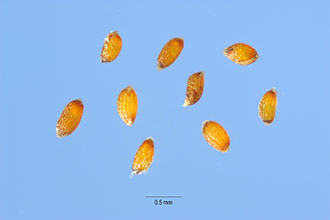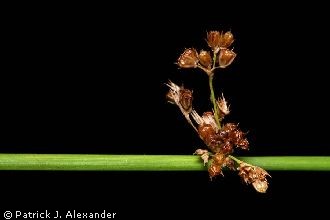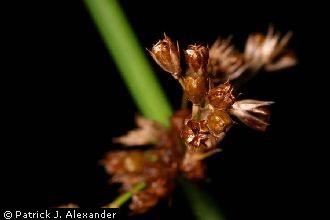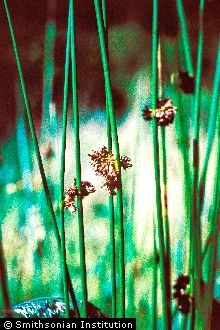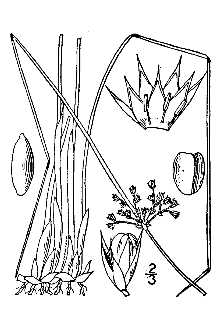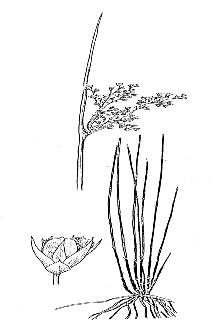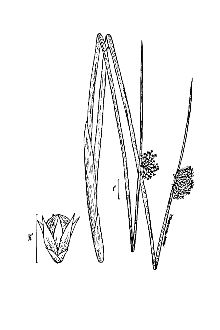Common Rush
Scientific Name: Juncus effusus L.
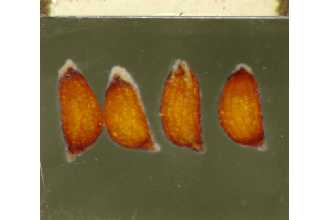
| General Information | |
|---|---|
| Usda Symbol | JUEF |
| Group | Monocot |
| Life Cycle | Perennial |
| Growth Habits | Graminoid |
| Native Locations | JUEF |
Plant Guide
Alternate Names
There are several taxonomic varieties of this species.
Uses
Ethnobotanic: Coiled basketry prevails in Southern California, with the mottled yellowish brown of soft rush providing a natural colored and variegated background (Turnbaugh and Turnbaugh 1986). Juncus stems are used in the coiled baskets of Southern California tribes such as the Cahuilla, Luiseño, Chumash, Diegueño, Agua Caliente, Gabrieliño, Juaneño, Death Valley Shoshone, and Fernandeno (Barrows 1967; Murphey 1959). The foundation material is made of Juncus balticus and Juncus effusus, and the sewing material is made of Juncus textilis. The Quinalt of western Washington used soft rush for plaiting tumplines for baskets (Gunther 1973). They also mixed soft rush with cattails to make string. The Snoqualmie used the stalks for tying things. The early sprouts of soft rush were sometimes eaten raw by the Snoqualmie of Washington (Gunther 1973). Juncus shoots were eaten raw, roasted in ashes, or boiled by Maidu, Luiseño, and others (Strike 1994). Owens Valley Paiute ate the seeds. Soft rush stalks was gathered in wetlands and was eaten on occasion by the Nlaka'pamux and Lillooet people of British Columbia (Kunlein and Turner 1991). Soft rush, also called candle rush by the Japanese, is used for tatami mats. Large mats were also made by California Indians by piercing holes in Juncus and threading cordage through the holes so the Juncus stalks were aligned side-by-side (Strike 1994). These flexible mats could be rolled and stored when not needed. Alfred Brousseau © Brother Eric Vogel, St. Mary's College @ CalPhotos Wildlife: A wide range of mammal and avian species depend on Juncus species for food and habitat (Hoag and Zierke 1998). Waterfowl, songbirds, and small mammals such as jack rabbits, cottontail, muskrat, porcupine, and gophers (Martin 1951) eat rush seeds. Rushes provide habitat for amphibians and spawning areas for fish. Muskrats feed on the rootstalks of soft rush, and various wetland wading birds find shelter among the stems. Livestock: Cattle will graze Juncus effusus late in the season after more palatable plants are eaten. Rushes tend to be resistant to grazing pressure and fairly unpalatable to cattle, so tend to increase in species composition in pastures. Erosion & Restoration: Rushes provide the following conservation uses: erosion control, sediment accretion and stabilization, nutrient uptake and transformation, wildlife food and cover, restoration and creation of wetland ecosystems, and wastewater treatment applications. The rhizomatous nature, nitrogen fixation capabilities, dense root system, and phenotypic plasticity to flooding and drought stress provide high soil and slope stabilization capabilities, particularly in areas with flooded soils or fluctuating hydrology. The rhizomes form a matrix for many beneficial bacteria, making this plant an excellent addition for wastewater treatment. This species can have invasive characteristics in certain situations.
Status
Please consult the PLANTS Web site and your State Department of Natural Resources for this plant’s current status, such as, state noxious status and wetland indicator values, , Use soil moisture sensors to measure the soil moisture of Common Rush.
Description
General: Rush Family (Juncaceae). Soft rush is a rhizomatous, perennial herb with a large, tufted, cespitose growth form. Juncus effusus stems are stout but soft, 5-15 dm tall and 1.5-3 mm wide. The basal sheaths are bladeless or the inner ones tipped with a short awn, the edges usually overlapping nearly to the subtruncate or emarginate tip, with the veins converging at the tip. The leaves are dull chocolate brown or chestnut-colored at the base, the inner sheaths dark toward the summit. The inflorescence is a many-flowered, loosely clustered panicle, 2- 10 cm long. The capsule is oblong-obovoid, of about the same length as the perianth, obtuse or retuse. The seeds are retucilate. Distribution: For current distribution, please consult the Plant Profile page for this species on the PLANTS Web site. Soft rush occurs in wet places on hillsides or valley flats below 2500 m. It occurs through California to British Columbia, the eastern United States, Mexico, and Eurasia.
Establishment
Juncus effusus is easily propagated from bare root stock or seedlings, from container stalk, or directly seeded into the soil. Bare root stock or seedlings are preferred revegetation methods where there is moving water. These plants can be invasive. They are useful for stabilization and revegetation of disturbed areas. Juncus effusus requires moderate summer watering (irrigation), generally 1 - 4 times per month depending on the absorption rate and water retention capacity of the soil. Salt rush plants may need to have their roots in moist or wet soils. These native plants are especially good for stabilizing or restoring disturbed or degraded areas for erosion and slope control. Live Plant Collections: The following information on Juncus balticus is provided by J. Chris Hoag and Mike Zierke (USDA, NRCS, Plant Materials Center, Aberdeen, Idaho). Due to their taxonomic and habitat similarity, it is likely that Juncus effusus establishes in a similar manner. • Planting plugs is the surest way to establish a new stand of this species. Plug spacing of 25-30 cm will fill in within one growing season. Fluctuating the water level during the establishment period may speed spread of Juncus. Water levels can be managed to enhance spread and control weeds. • Clip leaves and stems to 15 to 25 cm (6 to 10 inches) before planting; this allows the plant to allocate more energy into root production. Transplants should be planted as soon as possible in moist (not flooded or anoxic) soils. Plants should be transported and stored in a cool location prior to planting. The roots should always remain moist or in water until planted. • Soil should be kept saturated after planting. Plants can tolerate 2.5 - 8 cm of standing water as long as the level fluctuates over the growing season. Allow roots to become established before flooding soils if possible. • Ideally, plants should be planted in late fall just after the first rains (usually late October to November). Survival is highest when plants are dormant and soils are moist. • Fertilization is very helpful for plant growth and reproduction. Many more seeds are produced with moderate fertilization. Seed Collections: The flowering period is late May to August, occasionally to September. Seed ripens in early August. Phenology will change by area, aspect, elevation, and specific site conditions. • Seed may be collected by hand, using a pair of hand shears, or with a gas-powered handheld seed harvester. • The tiny, black seeds are easily lost from the capsules when collecting by hand. Be careful to keep capsules upright before putting in collection bag. Use paper sacks when collecting seeds for this species. • To clean the seed, run the collection through a hammermill to break up debris and knock the seeds loose. Use a 1/20 inch screen on the top and a solid sheet on the bottom of the seed cleaner. Adjust the air flow to blow off the chaff. The cleaning process can be speeded up by shaking the hammermilled collection to settle seed to the bottom of the pan. The top portion of the chaff can then be discarded and the seed-rich mixture that is left in the bottom can be run through the seed cleaner. Seed germination in greenhouse: • Seeds need light, moisture and heat for germination. Soaking the seeds in water for 1 - 7 days will decrease the time the seed takes to sprout. • To grow seeds, place on soil surface and press in lightly to assure good soil contact. Do not cover the seed. Soil should be kept moist. Greenhouse should be kept hot (32-38°C). • Seeds begin to germinate in approximately 1 week. Maintain soil moisture until plants are to be transplanted. Seedlings cannot withstand long periods without water while growing in the greenhouse. • Plants are ready in 100 - 120 days to come out as plugs. By planting seeds in August, plugs are ready to plant in soil by November. These plants are very small; growing plants to a larger size will result in increased revegetation success.
Management
Hydrology is the most important factor in determining wetland type, revegetation success, and wetland function and value. Changes in water levels influence species composition, structure, and distribution of plant communities. Water management is absolutely critical during plant establishment, and remains crucial through the life of the wetland for proper community management (Hoag et al. 1995). Juncus species can tolerate periods of drought and total inundation. It is important to keep transplanted plugs moist, not flooded, until roots are established. Water levels can then be managed to enhance or reduce spread as well as control terrestrial weeds. Muskrats have evolved with wetland ecosystems and form a valuable component of healthy functioning wetland communities. Muskrats use emergent wetland vegetation such as Juncus species for hut construction and for food. Typically, an area of open water is created around the huts. Muskrat eatouts increase wetland diversity by providing opportunities for aquatic vegetation to become established in the open water and the huts provide a substrate for shrubs and other plant species. Juncus species tend to be fairly resilient to insect and disease problems. Aphids may feed on the stems, but rarely cause significant damage. If an insect or disease problem is encountered in the greenhouse, treatment options may be limited by cultural constraints if these plants are to be used by Indian basketweavers. Pesticide exposure is higher for basketweavers than the rest of the population. Juncus culms are split with the mouth to process basketry materials; therefore, an unusually high degree of human exposure and risk occur with plants designated for ethnobotanic use. Rushes are perennial, rhizomatous plants. In most cases, they will out-compete other species within the wetland area of the site, eliminating the need for manual or chemical control of invasive species. Traditional Resource Management: The management of Juncus effusus stands includes the following: ownership of prime basket rush sites, stimulation of new growth through harvesting stalks, periodic burning, and not harvesting when soils are very mucky and likely to be compacted. The stalks are cut above the rhizomes and roots, leaving plenty of buds to regrow new shoots. As with other rhizomatous species, harvesting stimulates new growth and maintains the clone in a juvenile or immature growth phase, where productivity is highest. Cultivars, Improved and Selected Materials (and area of origin) Contact your local Natural Resources
Conservation
Service (formerly Soil Conservation Service) office for more information. Look in the phone book under ”United States Government.” The Natural Resources Conservation Service will be listed under the subheading “Department of Agriculture.” This plant is available at many nurseries nationwide.
References
Cooke, S.S. 1997. A field guide to the common wetland plants of Western Washington and Northwestern Oregon. Seattle Audubon Society and Washington Native Plant Society. 414 pp. Dahl, T.E. and C.E. Johnson 1991. Status and trends of wetlands in the coterminous United States, mid-1970s to mid-1980s. USDI, FWS, Washington, D.C. 28 pp. Gunther, E. 1945 rev. 1973. Ethnobotany of western Washington. University of Washington Publications in Anthropology, 10(1). University of Washington Press, Seattle, Washington. Hickman, J.C. (ed.) 1993. The Jepson manual. Higher plants of California. University of California Press. 1399 pp. Hoag, J.C. n.d. Wetland plant fact sheet - Baltic rush (Juncus balticus). Interagency Riparian/Wetland Project. USDA, NRCS, Plant Materials Center, Aberdeen, Idaho. 3 pp. Hoag, J.C. & M. Zierke (February) 1998. A reference guide for the collection and use of ten common wetland plants of the Great Basin and Intermountain West. Riparian/Wetland Project Information Series No. 13. USDA, NRCS, Plant Materials Center, Aberdeen, Idaho. 13 pp. Hoag, J.C. & M.E. Sellers (April) 1995. Use of greenhouse propagated wetland plants versus live transplants to vegetate constructed or created wetlands. Riparian/Wetland Project Information Series No. 7. USDA, NRCS, Plant Materials Center, Aberdeen, Idaho. 6 pp. Hurd, E.G., N.L. Shaw, & L.C. Smithman 1992. Cyperaceae and Juncaceae - selected low-elevation species. Proceedings of Symposium of Ecology, Management, and Restoration of Intermountain Annual Rangelands, Boise, Idaho. May 18-22, 1992. Pages 380-383. Kuhnlein, H.V. & N.J. Turner 1991. Traditional plant foods of Canadian indigenous peoples. Nutrition, botany and use. Gordon and Breach Science Publishers. 633 pp. Manning, M.E., S.R. Swanson, T. Svejcar, & J. Trent 1989. Rooting characteristics of four Intermountain meadow community types. Journal of
Range
Management 42(4):309-312. Martin, A.C., H.S. Zim, & A.L. Nelson 1951. American wildlife and plants: A guide to wildlife food habits. Dover Publications, Inc., New York, New York. 500 pp. Merrill, R.E. 1970. Plants used in basketry by the California Indians. Acoma Books, Ramona, California. Moser, C.L. 1993. Native American basketry of southern California. Riverside Museum Press. 155 pp. Murphy, E.V.A. 1959. Indian uses of native plants. Mendocino County Historical Society. 81 pp. Strike, S.S. 1994. Ethnobotany of the California Indians. Volume 2. Aboriginal uses of California's indigenous plants. Koeltz Scientific Books, USA/Germany. 210 pp. Tiner, R.W. 1984. Wetlands of the United States: Current status and recent trends. USDI, FWS, National Wetlands Inventory, Washington, D.C. 58 pp. Timbrook, J. (June) 1997. California Indian Basketweavers Association newsletter. Turnbaugh, S.P. & W.A. Turnbaugh 1986. Indian baskets. Schiffler Publishing, Ltd., West Chester, Pennsylvania. Pages 194-205.
Fact Sheet
Alternate Names
Soft rush
Uses
The dense stands that soft rush form have deep fibrous root systems, which provide very good shoreline protection, filter suspended solids, up-take nutrients, and facilitate substrate oxidation. With its low pH and metal tolerances, soft rush often survives polluted conditions. The seed and vegetative parts of soft rush are utilized by waterfowl, muskrats, non-game birds, moose and domestic livestock for food or cover. The stems of this grass-like plant have been traditionally used for making floor mats, and chair seats.
Status
Please consult the PLANTS Web site and your State Department of Natural Resources for this plant’s current status (e.g. threatened or endangered species, state noxious status, and wetland indicator values).
Description
Juncus effusus is a slow spreading, clump forming, grass-like perennial which emerges from a stout branching rootstock. The short, finely divided rhizomes are 6 to 10 inches long, growing from 1/4 to 2 inches beneath the soil surface. The culms are smooth, erect, bright green and hollow, with reduced basal leaves. New shoots emerge and develop in late summer, reaching up to 4 feet tall at maturity the following spring. The flowers are inconspicuous in compact clusters to 4 inches long. The flowers emerge and mature from March to September, peaking in July. Pollination typically occurs by wind, but occasionally it is by insects. A three celled obovoid capsule develops after fertilization, which contains many small (.02 to .025 inch long) straw colored seeds. There are an estimated 18,000,000 seeds per pound. Due to the small size and tacky outer coating, the seed of Juncus effusus can be disseminated by wind, water or animals. After shatter, seeds may remain viable for greater than 60 years if over-topped with sediments.
Adaptation and Distribution
Distribution
Distribution
Robert H, Use soil moisture sensors to measure the soil moisture of Common Rush., Mohlenbrock USDA NRCS 1989 Midwestern Wetland Flora @USDA NRCS PLANTS Soft rush is naturally found throughout the temperate and sub-tropical areas of North America, Europe, and Asia, with the exception of the arid and high altitude regions, It inhabits fresh to brackish marshes, swamps, ditches, and moist seasonal wetlands and meadows, Soft rush is tolerant of diverse site conditions, but thrives in direct sun, finely textured soils, salinity less than 14ppt,, pH from 4,0 to 6,0, and shallow water (less than 6 inches), Common rush is distributed throughout most of the United States, For a current distribution map, please consult the Plant Profile page for this species on the PLANTS Website,
Establishment
Juncus effusus can be easily grown from seed or vegetative divisions, but seed dispersal is the primary means of natural reproduction. For germination to occur seed must be in contact with moist soil, receive direct sunlight, and over-winter on the soil surface. As long as moist conditions can be sustained and early competition reduced, seedlings will develop the following spring. Nursery and greenhouse production are effectively accomplished with seed or vegetative divisions. High seedling emergence can be expected under the controlled environment of the greenhouse. Moist stratification improves germination of soft rush. Stem divisions (bare root and containerized) are reliable when planted on adequate sites before mid-June. Greenhouse produced containerized stock can be ready for field planting 6 weeks after transplanting. Two year old clumps of soft rush will yield an average of 80 planting units. A planting unit should contain 3 to 5 culms. They can be planted by hand or mechanically.
Plant Traits
Growth Requirements
| Temperature, Minimum (°F) | -38 |
|---|---|
| Adapted to Coarse Textured Soils | Yes |
| Adapted to Fine Textured Soils | Yes |
| Adapted to Medium Textured Soils | Yes |
| Anaerobic Tolerance | Medium |
| CaCO3 Tolerance | Low |
| Cold Stratification Required | No |
| Drought Tolerance | Medium |
| Fertility Requirement | Medium |
| Fire Tolerance | High |
| Frost Free Days, Minimum | 120 |
| Hedge Tolerance | None |
| Moisture Use | Medium |
| pH, Maximum | 8.8 |
| pH, Minimum | 5.5 |
| Planting Density per Acre, Maxim | 4800 |
| Planting Density per Acre, Minim | 2800 |
| Precipitation, Maximum | 60 |
| Precipitation, Minimum | 18 |
| Root Depth, Minimum (inches) | 24 |
| Salinity Tolerance | Low |
| Shade Tolerance | Intolerant |
Morphology/Physiology
| After Harvest Regrowth Rate | Slow |
|---|---|
| Toxicity | None |
| Resprout Ability | No |
| Shape and Orientation | Erect |
| Active Growth Period | Spring |
| Bloat | None |
| C:N Ratio | Medium |
| Coppice Potential | No |
| Fall Conspicuous | No |
| Fire Resistant | Yes |
| Flower Color | Brown |
| Flower Conspicuous | No |
| Foliage Color | Dark Green |
| Foliage Porosity Summer | Moderate |
| Foliage Porosity Winter | Porous |
| Fruit/Seed Color | Yellow |
| Nitrogen Fixation | None |
| Low Growing Grass | No |
| Lifespan | Long |
| Leaf Retention | No |
| Known Allelopath | No |
| Height, Mature (feet) | 6.6 |
| Growth Rate | Moderate |
| Growth Form | Bunch |
| Fruit/Seed Conspicuous | No |
| Foliage Texture | Coarse |
Reproduction
| Vegetative Spread Rate | None |
|---|---|
| Small Grain | No |
| Seedling Vigor | High |
| Seed Spread Rate | Slow |
| Fruit/Seed Period End | Fall |
| Seed per Pound | 45359242 |
| Propagated by Tubers | No |
| Propagated by Sprigs | Yes |
| Propagated by Sod | No |
| Propagated by Seed | Yes |
| Propagated by Corm | No |
| Propagated by Container | No |
| Propagated by Bulb | No |
| Propagated by Bare Root | No |
| Fruit/Seed Persistence | Yes |
| Fruit/Seed Period Begin | Summer |
| Fruit/Seed Abundance | Medium |
| Commercial Availability | Routinely Available |
| Bloom Period | Summer |
| Propagated by Cuttings | No |
Suitability/Use
| Veneer Product | No |
|---|---|
| Pulpwood Product | No |
| Protein Potential | Medium |
| Post Product | No |
| Palatable Human | No |
| Palatable Graze Animal | Medium |
| Palatable Browse Animal | High |
| Nursery Stock Product | No |
| Naval Store Product | No |
| Lumber Product | No |
| Fodder Product | Yes |
| Christmas Tree Product | No |
| Berry/Nut/Seed Product | No |

